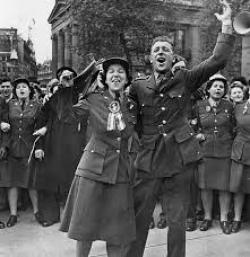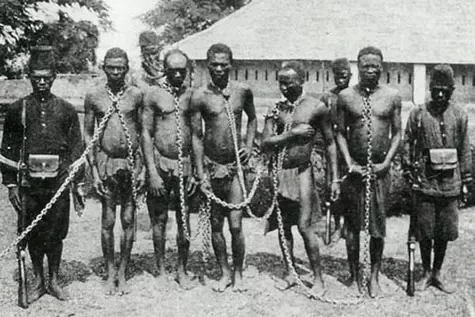By Beatrice Windsor
The Queen’s address to the nation and this month’s anniversary of VE-Day has evoked the memory of World War II. There’s been a lot of that from our self-appointed peers. Yes, we all stood together then, the rich man in his castle, the poor man at the gate, united as one against a common enemy.
We know it is true because of all those stirring war films we have watched from the cradle to the grave. The stoic ‘Oxbridge’ officer staring adversity in the face, with his loyal but lowly soldier by his side (usually a chirpy Cockney), while back on the home front, ‘fraffly’ well-spoken girls muck in with northern lasses for the war effort. It was a class truce, all for the good of the ‘nation’. That’s what happened, didn’t it?
True or false
Well, here’s your lock-down quiz for today. Which statements below are true, and which are false?
1. Thousands of the British aristocracy fled in the first two days of war being declared.
2. The Home Guard was trained by the International Brigade.
3. When the Blitz began, you needed to buy a platform ticket to take shelter in the London Underground.
4. The Dambusters were a bunch of lefties.
5. British Trotskyists produced more guns for the war effort than anyone else.
6. On US military bases, black US troops were not allowed to use the segregated canteens, but German POWs could.
7. The official newspaper of the 8th Army demanded four Trotskyists imprisoned in Britain be released.
8. The battle for the bridge at Arnhem concluded with a rousing chorus of the Internationale.
9. A Marxist was elected Prime Minister of the British Army’s ‘Forces Parliament’ in Benghazi, Libya.
10. The Viceroy of India denounced the RAF as the ‘Red Air Force’.
Here are the answers
Yep, they are all true. Here’s the answers:
1. Angus Calder, in his book The People’s War, describes how 5,000 of the wealthy crowded onto cruisers at Southampton, and sailed for the safety of America in the first 48 hours of war being declared. A further two million of the rich and upper-middle classes fled to their country estates or holiday homes in Wales, Devon and Scotland. Or ‘funk holes’ as the workers deridingly called them.
2. The commander of the British section of the International Brigade during the Spanish Civil War, Tom Wintringham, had split from the Communist Party and was demanding the people should be armed. With the formation of the Home Guard, Wintringham brought over three Spanish miners who were expert in destroying tanks, and set up a School of guerrilla warfare at Osterley Park. After 5,000 Home Guard as well as a Guards Regiment had passed through Wintringham’s capable hands, Osterley was brought into the official training programme.
3. Sheltering in the London Underground during the Blitz is an iconic image. But people fled to the tube because the authorities had not built enough air-raid shelters. The authorities tried to stop the practice, but people bought platform tickets en masse and then refused to leave. The authorities eventually relented.
4. Many of those who volunteered for 617 Squadron, the ‘dambusters’, were socialists and internationalists who disagreed with the blanket bombing of German civilians, and instead wanted to attack military and economic targets only. Several books about the dambusters carry a picture of the air crew mess at the time – centre piece on the mess notice board was a large picture of Karl Marx.
5. Well, sort of true. In Nottingham, the revolutionary socialists of the Workers International League took the leadership of the trade unions at the local Royal Ordnance Factory, after beating off attempts by the government to transfer skilled engineers to the lesser-paid private sector. With the WIL in the lead, the factory’s Joint Production Committee was effectively under trade union control, being run by the shop stewards, while the convenor, WIL member Jack Pemberton, was given his own office, a rarity in those days. Far from the factory falling into chaos, this elementary form of workers’ control ensured ROF Nottingham was the most efficient in the Royal Ordnance group, producing 13,000 guns and 23,000 gun barrels, yet still retaining the best terms and conditions for factory workers.
6. ‘Jim Crow’ segregation laws on US Army bases were rampant, which did indeed mean white German POWs could use the facilities that black soldiers could not. It led to many riots on US Army bases, leading to pitched gun battles with many killed. The US military attempted to bring the segregation laws to England, as the US Army amassed for D-Day. The author Anthony Burgess recalled an incident in Bamber Bridge in Lancashire, where US black troops were stationed. When US military authorities demanded that the town’s pubs impose a colour bar, the landlords responded with signs that read: “black troops only”. More sinister was the ‘Battle of Bamber Bridge’. White US Military Police began harassing black troops in a pub. Supported by white British soldiers, the black Americans fought back against the MPs, but were arrested. Locals warned the other black troops back at base, and they marched on the town: the MPs responded by opening fire, killing one black soldier.
7. In a bid to quell a strike wave in 1944, the government imprisoned four members of the Trotskyist Revolutionary Communist Party. There was a mass campaign in the labour movement for their release, which reached as far as the victors of El Alamein, the 8th Army. A petition was circulated among the troops, and such was the pressure that the official Army newspaper, the Eighth Army News, carried a sympathetic article headlined; “RIGHT TO STRIKE IS PART OF THE FREEDOMS WE FIGHT FOR”.
8. The film, A Bridge Too Far, depicts the defeated British paratroopers mournfully signing ‘Abide with me’ as they surrender. The renowned military historian Antony Beevor in his book Arnhem described what really happened: “They sang while marching and grinned or made V for Victory signs… prisoners also sang the ‘Internationale’ or the ‘Red Flag’.” Nor did the film mention the paratroopers’ popular top sniper, Corporal Bolton. He was black.
9. To reinforce ‘parliamentary democracy’ in the 8th Army in North Africa, military chiefs set up a Forces Parliament, with elections to office. RCP member Arthur Leadbetter was elected both Prime Minister and Home Secretary of the Benghazi Forces Parliament – beating both his Labour Party and Communist rivals. Leadbetter was quietly posted off to Cairo.
10. At the end of the war, General Wavell, the Viceroy of India, dubbed the RAF as the ‘Red Air Force’ after an incident involving Nehru, the Indian independence leader. He had been banned by South East Asia Command from attending a conference in Burma of national liberation leaders. Nehru had been summoned to see the SEAC commander Lord Mountbatten instead. But while he was being ferried there by a RAF transport plane, it mysteriously developed ‘engine trouble’ and diverted to Rangoon, ensuring Nehru made the conference. The rank and file servicemen were beginning to have their say about the future of the British Empire.
So, as you can see, they have their version of history – and we have ours: the real one.
May 7, 2020



